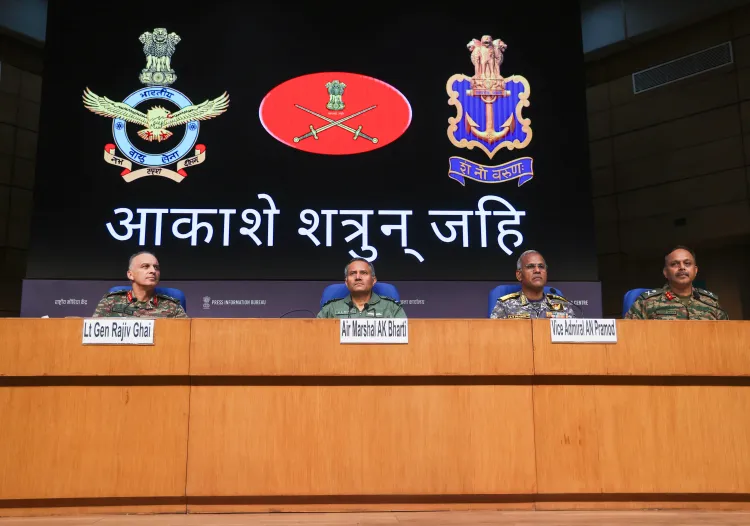How did India respond decisively to Pakistan's aggression?

Synopsis
Key Takeaways
- India's robust defense measures effectively neutralized threats.
- Operation Sindoor showcased coordination among military branches.
- No violations of territorial integrity were made during operations.
- Advanced technologies played a key role in air and maritime defense.
- Clear deterrence message to potential aggressors was communicated.
New Delhi, May 12 (NationPress) Senior military leaders on Monday shared an in-depth operational summary of India’s strong defence strategies and readiness during and following Operation Sindoor, a decisive reaction to the recent terrorist attack in Jammu and Kashmir’s Pahalgam.
During a high-level briefing, Lt Gen Rajiv Ghai, Director General of Military Operations (DGMO), alongside Vice Admiral A.N. Pramod, Director General of Naval Operations, elaborated on the extensive coordination among the Indian Army, Air Force, and Navy, showcasing a defence strategy that was both strategic and impregnable.
Army's Role: Defending without crossing borders
Lt Gen Ghai emphasized that India did not cross the Line of Control (LoC) or the International Border (IB) during its operations. “All defensive actions were conducted from within Indian territory,” he stated, countering speculative claims of escalation.
He pointed out the shift in terrorist tactics, especially the concerning trend of targeting civilians, highlighting the 2024 attacks at Shiv Khori, a renowned Hindu shrine dedicated to Lord Shiva, and Pahalgam as pivotal moments in strategic threat assessment.
Between May 9 and 10, India’s comprehensive air defence network was challenged as waves of drones, launched by the Pakistan Air Force (PAF), attempted to infiltrate Indian airspace. “Not a single PAF drone could breach the defence shield,” Lt Gen Ghai declared.
In his words: “From ashes to ashes, dust to dust” — a phrase used to highlight the complete neutralization of enemy UAVs before they could inflict harm.
He further confirmed that some drones were downed by shoulder-fired weapons, while unarmed aerial systems (UAS) were neutralized using integrated counter-drone technologies. The Border Security Force (BSF) received commendation for its vigilance and contributions, with accolades extending from its Director General to the frontline personnel.
Navy’s Role: Total maritime superiority
Vice Admiral A.N. Pramod outlined the Navy’s operations, underscoring that continuous monitoring, detection, and target tracking were essential for maintaining maritime supremacy.
Utilizing advanced sensors and real-time intelligence, the Navy operated under a layered fleet air defence system capable of neutralizing aerial threats such as drones, missiles, and aircraft.
India’s Carrier Battle Group, outfitted with MiG-29K fighters and airborne early warning aircraft, acted as the principal air defence line, ensuring total control over the maritime environment.
“No hostile aircraft could approach the Indian fleet,” Vice Admiral Pramod asserted, highlighting the combat readiness and precision of naval aviation pilots conducting operations both day and night.
The Navy also validated its anti-missile and anti-aircraft capabilities amidst complex threats, reinforcing India’s operational dominance in the region. Pakistani air and naval forces were effectively confined along the Makran coast, unable to project power or execute any significant retaliation.
“Our naval presence ensured that India could strike at will, if necessary,” the Vice Admiral noted, emphasizing India’s deterrence through dominance in the Indian Ocean Region.
The joint operations under Operation Sindoor not only illustrated India’s defensive resilience but also conveyed a clear strategic message: any future acts of cross-border terrorism will be met with swift, decisive, and overwhelming force across all domains — land, air, and sea.










